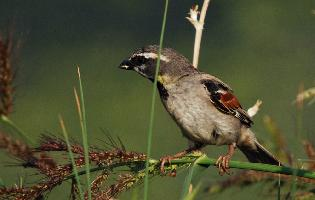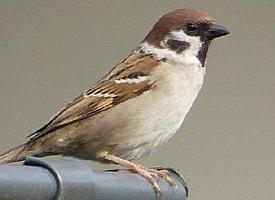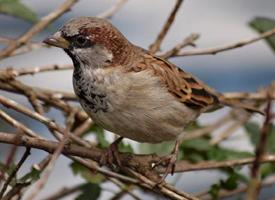
Váhy a míry
| Délka | od 12 do 13 cm |
|---|
Popis zvířete
The Dead Sea Sparrow (Passer moabiticus) is a small, yet intriguing bird species belonging to the sparrow family. It is named after its notable presence in regions around the Dead Sea, although its range extends through parts of the Middle East and Central Asia, encompassing areas like Jordan, Israel, Syria, Iraq, Iran, and Kazakhstan. This bird is of particular interest to ornithologists and bird watchers due to its specific habitat preferences and unique behaviors.Adult Dead Sea Sparrows are characterized by their relatively small size, measuring about 13 to 14 centimeters in length. They exhibit sexual dimorphism, meaning males and females can be distinguished by their appearance. The male Dead Sea Sparrow boasts a striking plumage during the breeding season; it has a bright chestnut crown and nape, contrasting sharply with a white cheek patch and a black bib. Its upperparts are generally grayish-brown, while the underparts are pale with a clean, whitish appearance. The female, on the other hand, has a more subdued coloration with less pronounced markings, her plumage blending more seamlessly with the arid landscapes of her environment.
These sparrows inhabit semi-arid regions, often near water sources such as rivers, streams, and oases, which are scarce in their desert surroundings. They show a preference for areas with dense vegetation, such as reed beds and tamarisk trees, where they can find food, shelter, and nesting sites. The Dead Sea Sparrow is a sociable bird, frequently found in small flocks outside the breeding season. It feeds primarily on seeds and small insects, which it forages from the ground or among vegetation.
Breeding behavior of the Dead Sea Sparrow is particularly noteworthy. They are monogamous birds, forming strong pair bonds during the breeding season. The nest, constructed by both male and female, is a neat, cup-shaped structure placed in the branches of trees or shrubs. The female lays between three to five eggs, which she incubates for about two weeks until they hatch. Both parents are involved in feeding the chicks, which fledge approximately two weeks after hatching.
Despite their resilience and adaptability to harsh environments, Dead Sea Sparrows face threats from habitat loss and degradation, primarily due to human activities such as agriculture expansion, water diversion, and urbanization. While currently not listed as endangered, their population trends are not well documented, and conservation efforts are needed to ensure their habitats are preserved.
In summary, the Dead Sea Sparrow is a fascinating and resilient bird species, adapted to life in some of the most challenging environments. Its unique characteristics and behaviors make it a subject of interest for conservationists and bird enthusiasts alike, emphasizing the importance of ongoing efforts to protect its natural habitats and ensure its survival for future generations to appreciate.
Podobná zvířata
Nové fotografie zvířat
Top 10 zvířat
- Chinese water dragon (Physignathus cocincinus)
- Galápagos tortoise (Geochelone nigra complex)
- Dolphin gull (Leucophaeus scoresbii)
- Japanese macaque (Macaca fuscata)
- Colombian red howler (Alouatta seniculus)
- Sea urchins (Echinoidea)
- Moustached guenon (Cercopithecus cephus)
- Diana monkey (Cercopithecus diana)
- Colossal squid (Mesonychoteuthis hamiltoni)
- Common house mosquito (Culex pipiens)

